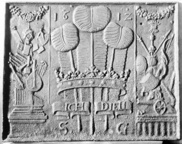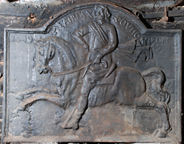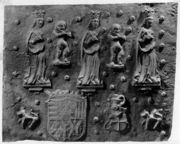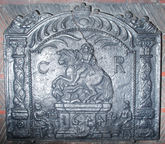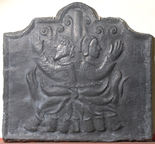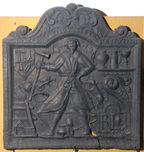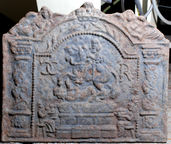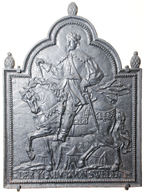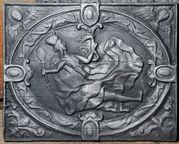-
1291
Description: Rectangular shape; astragal with cavetto-moulded edging; decoration in three vertical sections each divided by a fillet; central section: three ostrich feathers within a coronet and a motto scroll - ICH DIEN (I serve); at the top, the date split either side of the uppermost feather; at the bottom, initials - SG - split either side of the quills; left panel: on a pedestal, an arrangement of musical and scientific instruments and books below a floral swag with a central rose; right panel: on a palisade, a triumph of martial arms - cannon, drum, shield, spear, flag etc. - beneath a floral swag and handful of arrows.
Notes: The three ostrich feathers within a coronet and the motto, Ich Dien, are the badge of the Prince of Wales. Probably a fireback in honour of Henry Frederick, Prince of Wales, oldest son and heir of King James VI of Scotland, I of England, with the date added to commemorate his death in 1612. The initials are likely to be those of the pattern maker.
Inscription: 16 12 / ICH DIEN / S G
- Decoration tags:
- rectangular (shape)
- astragal with cavetto (edging)
- whole carved pattern
- individual numbers
- heraldic
- pictorial
- historical
- architectural
- royal
- text
- objects
Manufactured: in 1612 in the Eifel area of Germany.
Current location: not known.
Museum number: RBA 37533 (part of the Ahrgau-Museum, Ahrweiler museum group)
- Attached to series:
- Prince of Wales firebacks
- Miscellaneous royal firebacks
-
37
Description: Arched rectangular shaped; cavetto moulded edging; male figure in dress of the period, right hand on hip, left hand holding reins, astride a prancing horse; date and inscription (letter 'N' reversed) follow inside top edge.
Notes: Thomas Fairfax, 3rd Lord Fairfax of Cameron (1612-1671), commander of the New Model Army, which probably prompted the epithet, conqueror. 1649 was the year of Charles I's execution, to which Fairfax was opposed.
Copies of this fireback are known.
Inscription: 1649 LD FAIRFAX COVNQVIROR
- Decoration tags:
- rectangular with round arch (shape)
- cavetto (edging)
- whole carved pattern
- pictorial
- historical
- text
- animals
- humans
Manufactured: in 1649 in England.
Current location: in private hands, Cowbeech, East Sussex, England.
- Attached to series:
- Commemorative firebacks
-
1025
Description: Quasi-rectangular shape; top, crowned robed statuary figure holding a book, repeated three times, interspersed with a naked child statuary figure playing a flute; bottom, shield and coronet to left, small shield, helm and crest to right, all between a crude dog figure repeated on each side; the whole plate dotted randomly with a repeated small gadrooned bead stamp.
Notes: The figures are from wall-mounted statuary. The shield and coronet are those of the Duchy of Lorraine prior to 1538; blazon: Quarterly, 1. barry of eight gules and argent (Hungary) impaling azure semy-de-lis Or a label gules (Naples); 2. argent a cross potent and four crosslets Or (Jerusalem) impaling Or four pallets gules (Aragon); 3. azure semy-de-lis Or a bordure gules (Valois-Anjou); 4. azure crusilly fitchy, two barbels addorsed Or (Bar); overall an inescutcheon Or a bend gules three alerions argent (Lorraine). The figure holding the book is that of St Catherine of Siena (see von den Driesch, pp. 220, 222).
Arms: Duchy of Lorraine
- Decoration tags:
- rectangular (shape)
- none (edging)
- carved stamps
- heraldic
- historical
- armorial
- animals
- humans
- objects
Manufactured: in the early-16th century in the Lorraine area of Germany.
Current location: not known.
- Attached to series:
- Foreign armorial firebacks
-
280
Description: Arched rectangular shaped central panel, bead edging (top and sides), pedestal bearing a supine male figure with headband being trampled by a horse, facing left, mounted by a rider with long hair, facing to the front; on each side of the plinth is a seated figure wearing a hat, with a basket of fruit; above the rider are crescent lines representative of clouds; the inscription is split either side of the horse; the date (‘7’ rotated and, with ‘4’, reversed) is on the die of the pedestal; arched rectangular shaped border, fillet edging, on each side a Solomonic column with vine decoration; in the arch, symmetrical parallel curved lines with a central oval cartouche beneath a crown; on top of each shoulder of the plate a figure in repose.
Notes: The equestrian figure is derived from the statue of Charles II erected in Stocks Market, London, in 1672. Originally to be of Jan Sobieski, later king of Poland, riding down a Tatar, it was altered to represent Charles, and the Tatar’s face was changed to that of Oliver Cromwell; the statue attracted a fair degree of derision. The statue is now at Newby Hall, near Ripon, North Yorkshire. Another version (no. 464), probably by the same pattern-maker, omits a date and has altered initials.
Copies of this fireback are known.
Inscription: C R / 1674
- Decoration tags:
- 'Dutch' (shape)
- cavetto (edging)
- whole carved pattern
- individual numbers
- pictorial
- historical
- architectural
- text
- animals
- humans
Manufactured: in 1674 in England.
Current location: Chequers, Ellesborough, Buckinghamshire, England.
Citation: Lloyd, N., 1925, 'Domestic Ironwork I', Architectural Review, 58, pp. 58-67.
- Attached to series:
- Carolean 'Dutch' series
- Commemorative firebacks
-
396
Description: Cavetto-canted rectangle with arched top; astragal and cavetto edging (top and sides); pictorial; back-to-back figures of a bearded man and a woman in a poke bonnet, both dressed in tunics, their arms raised, respectively left and right; they are chained to a vertical pole; below, flames issue from vertically stacked logs, while smoke rises above them; the physical proportions of the figures are naïve, the man’s eyes being over-large, as are the hands of both.
Notes: The design is a free adaptation of an illustration from The Book of Martyrs by John Foxe (1563), a copy from a back originally noted at Brick Cottage, Burwash, Sussex, in 1871. This may be the design of fireback referred to in an enquiry printed in the St James's Chronicle, or British Evening Post, of 9 August 1788, which described it as 'having two Bishops burning at Stakes thereon' at a house in Warwickshire. At an auction sale in 2017 the same design of fireback was interpreted as the burning of Bishops Latimer and Ridley in 1555. Protestants were burnt to death at several Wealden locations as well as elsewhere in the south-east of England during the reign of Mary I, notably at Canterbury and Lewes. The subject of the fireback should be regarded as symbolic rather than commemorating any individual martyrs.
Copies of this fireback are known.
- Decoration tags:
- rectangular with canted top corners and round arch (shape)
- astragal with cavetto (edging)
- whole carved pattern
- pictorial
- historical
- humans
Manufactured: in the late-16th to early-17th century in the Weald area of England.
Current location: Anne of Cleves House, Southover High Street, Lewes, East Sussex, England.
Museum number: LH000.903 (part of the Sussex Archaeological Society museum group)
Citation: Butterfield, W. R., 1916, 'Old Wealden Firebacks', The Connoisseur, 46, pp. 197-209.
Citation: Dawson, C., 1903, 'Sussex Iron Work and Pottery', Sussex Archaeological Collections, 46, pp. 1-54.
Citation: Paine, C., Aug 2013, 'Mystery of the Two Martyrs', Sussex Past and Present, 130, pp. 6-7.
Citation: Straker, E., 1931, Wealden Iron (London, Bell).
- Attached to series:
- Commemorative firebacks
-
429
Description: Arched rectangular shape with symmetrical floral scrolls on top; three horizontal plank lines; ovolo moulding all round edge of main panel; inscription along top edge of panel; central figure of a bearded man wearing knee-length coat, belted at waist, and holding a sledge hammer in his right hand, his left arm akimbo; both feet pointing to his right; various ‘tools’ of his trade arranged about him; (clockwise from top left) shield, the quarters containing a masonry hammer, a firedog, a weight, and a pair of pincers; the date split on either side of his head; a floral console supporting a shelf bearing a flagon, a tankard and a goblet; a fireback bearing the letters RL and a diamond shape; from the top of the fireback a dog leaping up at its master; between the man's legs a long-handled ladle, a weight and a cooking pot; a ringer, used to pull slag off molten iron; part of the elevation of a blast furnace, with wooden framework, casting house, and flames issuing from the top; an ore basket, wheelbarrow and a charcoal clamp
Notes: The 'Lenard' fireback; a much-copied plate. Items relating to the founder's working life are displayed to the left of the figure, those to the right reflecting his domestic life. Its individualistic design and naïve figuration are the key to identifying a distinct group of firebacks, all probably made at Brede. A pastiche of this fireback also exists (no. 668), with which it is sometimes confused.
Copies of this fireback are known.
Inscription: RICHARD LENARD FOVNDER AT BRED FOVRNIS [each D is reversed] / 1636 / RL
- Decoration tags:
- rectangular with round arch (shape)
- ovolo (edging)
- whole carved pattern
- planklines
- pictorial
- historical
- text
- animals
- humans
- objects
Manufactured: in 1636 at Brede Furnace in the Weald area of England.
Current location: Anne of Cleves House, Southover High Street, Lewes, East Sussex, England.
Museum number: LH000.906 (part of the Sussex Archaeological Society museum group)
Citation: Anon., 30 Dec 1911, 'Sussex Backs and their Story', The Ironmonger.
Citation: Dawson, C., 1903, 'Sussex Iron Work and Pottery', Sussex Archaeological Collections, 46, pp. 1-54.
Citation: Gardner, J. S., 1898, 'Iron Casting in the Weald', Archaeologia, 56, 1, pp. 133-164.
- Attached to series:
- Brede group
- Personal firebacks
-
464
Description: Arched rectangular shaped central panel, bead edging (top and sides), pedestal bearing a supine male figure with headband being trampled by a horse, facing left, mounted by a rider with long hair, facing to the front; on each side of the plinth is a seated figure with a basket of fruit; the inscription is split either side of the horse; arched rectangular shaped border, fillet edging, on each side a Solomonic column with vine decoration; in the arch, symmetrical parallel curved lines intertwined beneath a crown; on top of each shoulder of the plate a female figure in repose.
Notes: The equestrian figure is derived from the statue of Charles II erected in Stocks Market, London, in 1672. Originally to be of Jan Sobieski, later king of Poland, riding down a Tatar, it was altered to represent Charles, and the Tatar’s face was changed to that of Oliver Cromwell; the statue attracted a fair degree of derision. The 'CC' monogram is likely to be for Charles and Catherine (of Braganza). The statue is now at Newby Hall, near Ripon, North Yorkshire. Another version (no. 280), probably by the same pattern-maker, is dated 1674 and has altered initials.
Copies of this fireback are known.
Inscription: CC [interlocked, and the first reversed] R
- Decoration tags:
- 'Dutch' (shape)
- ovolo (edging)
- whole carved pattern
- individual letters
- pictorial
- historical
- text
Manufactured: in the mid- to late-17th century in England.
Current location: in private hands, Little Horsted, East Sussex, England.
- Attached to series:
- Carolean 'Dutch' series
- Commemorative firebacks
-
573
Description: Rectangular with fillet sides and bottom; scrolled foliage on outside edges; date in narrow rectangular panel at bottom; central pictorial representation of four historical figures (see below), three male in mid-17th century armour, and one female; tripple arched top formed of rococo scrolls, a putto forming the middle arch.
Notes: The inscription may relate to the defeat of the Spanish at s'Hertogenbosch (den Bosch - ENDE BUSH) in 1629, and Wesel. von den Driesch states that the figures, from left to right, are: Prinz Fredrik Henrik of Oranje, his daughter, Luise Henriette, Prince Maurice of Nassau, and the Elector Friedrich Wilhelm of Brandenburg, who married Luise Henriette. German craftsmanship may account for the incorrect spelling of Dutch names. Mitford collection, Petworth House.
Copies of this fireback are known.
Inscription: PRESNTZI VAN WESEL ENDE BVSH / 1667
- Decoration tags:
- rectangular with three arches (shape)
- complex individual (edging)
- whole carved pattern
- pictorial
- historical
- royal
- text
- humans
Manufactured: in 1667 possibly in the Siegerland area of Germany.
Current location: Petworth House, Petworth, West Sussex, England.
Museum number: NT/PET/M/64 (part of the National Trust museum group)
- Attached to series:
- 'Dutch' Miscellaneous Firebacks
- Commemorative firebacks
-
574
Description: Arched rectangular central panel with arch and bead edging within a similarly shaped cavetto-moulded border and pomegranates on to and on the ach shoulder of the plate; pictorial representation of the king of Sweden mounted on a horse.
Notes: The king would be Gustav II. There is a companion fireback bearing the image of Prince Fredrik Henrik of Oranje. Mitford collection, Petworth House.
Copies of this fireback are known.
Inscription: DIE KONINCK VON SWEDEN
- Decoration tags:
- rectangular with arch above arch (shape)
- cavetto (edging)
- whole carved pattern
- pictorial
- historical
- royal
- text
- animals
- humans
Manufactured: in the mid- to late-17th century in the Siegerland area of Germany.
Current location: Petworth House, Petworth, West Sussex, England.
Museum number: NT/PET/M/65 (part of the National Trust museum group)
- Attached to series:
- 'Dutch' Miscellaneous Firebacks
- Commemorative firebacks
-
598
Description: Rectangular with fillet edging; central, oval panel with fillet edging containing the semi-reclining, begowned figure of Cleopatra, a mirror/sceptre in her right hand and an asp in her left hand; oval border with astragal and fillet edging and undulating foliage; in each of the top spandrels, a face of a putto; in the bottom spandrels, a triangular design of swirled foliage; at the centre of each side, overlapping the central oval border, an oval cartouche with scrolls in the inward facing side; four horizontal plank lines regularly spaced.
Notes: The naivety of the figuration and the similarity of the scrolled designs suggest that this may be the work of the same pattern-maker as the Lenard fireback. Three tapestries of the death of Cleopatra, one of them made for the Swedish royal court, were inspired by artwork by Karel van Mander II (1579-1623), which is likely to have been the inspiration for this fireback as well.
- Decoration tags:
- rectangular (shape)
- fillet (edging)
- whole carved pattern
- planklines
- pictorial
- historical
- humans
Manufactured: in the mid-17th century in the Weald area of England.
Current location: Mark Ripley Forge & Fireplaces, Northbridge Street, Robertsbridge, East Sussex, England.
- Attached to series:
- Brede group
